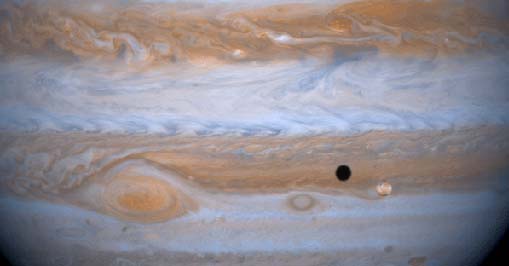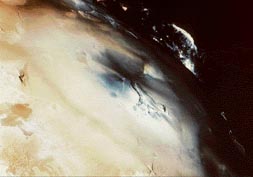Io

Io is the closest of the four largest moons of Jupiter. These moons are called the "Galilean moons" because they were first observed by Galileo.
 | The first images of Io from the Voyager spacecraft were dramatic indeed, showing a surface with reds, browns and yellows in patterns which reminded one observer of a "giant pizza". Io is the most volcanically active body in the entire solar system. Voyager I photographed eight erupting volcanoes! Four of them were still active when Voyager II arrived 4 months later. The volcanic activity contributes sulfur and other ions to the charged particle field around Jupiter, interacting with its strong magnetic field. These charged particles are swept around the planet and form a donut-shaped region called the Io plasma torus. These three images areNASA images from Voyager missions |
 |  These Voyager images show volcanoes erupting. Some material was observed at heights up to 200 km. Their dramatic heights are significant compared to the radius of the moon as shown in the edge image at left. | The volcanoes of Io eject material at up to 2 km/s, a much higher speed than any volcanic ejection on the Earth. |
Except for the locations of the active volcanoes, the surface of Io is extremely smooth. Apparently the volcanic action is so intense and continuous that flow from the volcanoes smooths out any irregularities and erases impact craters. A thin atmosphere of sulfur dioxide exists on the moon, presumably from the eruptions.
Why is Io so volcanically active? The energy which drives the continuous volcanism must come from the tidal influences of Jupiter on this nearby moon. By the inverse square law for gravity, the force on the near side of the moon is stronger than on the far side. Using the orbital data for Io, the force on the near side of Io is about 1.7% stronger than the force on the far side. But for the Earth's moon, the force on the near side is 1.8% stronger than that on the far side, and it is not volcanically active - why the difference? The answer is that for Earth's moon, the tidal forces long ago brought it into a state of synchronous rotation with the Earth, so that the same side of the moon faces the Earth at all times. Under that condition, the stresses which are caused in the moon by this force differential remain the same, and the forces do no work. For work to be accomplished, there must be motion in the direction of the force. In the case of Io, the rotation is not synchronous, although is is very close. Io has three other large companion moons which exert forces on it, resulting in a slightly elliptical orbit for which the same side does not always face Jupiter. The direction of greatest tidal distortion changes with time, so the forces exerted by Jupiter cause motion to re-establish the "stretching" of the moon in the direction of the forces. These forces therefore do work to achieve that motion - providing energy to drive the volcanic processes. The power from these tidal process which heats Io is estimated at 100 million megawatts!
The modeling of the interior of Io suggests that it has an iron/iron sulfide core and a rocky mantle. With the enormous heating energy of the tidal processes, much of the interior is soft or molten. This energy leads to geyser-like, high-temperature eruptions from the surface.
| Images of Io from Galileo |
Jupiter Concepts
Solar System Illustration
Solar System Concepts
References
Chaisson & McMillan,
Ch 11.
| HyperPhysics********** Astrophysics | R Nave |